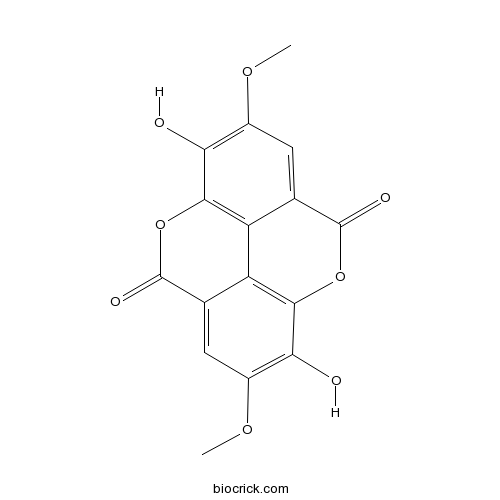4,4'-Di-O-methylellagic acidCAS# 3374-77-4 |

Quality Control & MSDS
3D structure
Package In Stock
Number of papers citing our products

| Cas No. | 3374-77-4 | SDF | Download SDF |
| PubChem ID | 11580745 | Appearance | Powder |
| Formula | C16H10O8 | M.Wt | 330.0 |
| Type of Compound | Phenols | Storage | Desiccate at -20°C |
| Solubility | Soluble in Chloroform,Dichloromethane,Ethyl Acetate,DMSO,Acetone,etc. | ||
| SMILES | COC1=C(C2=C3C(=C1)C(=O)OC4=C3C(=CC(=C4O)OC)C(=O)O2)O | ||
| Standard InChIKey | UMWZIZVOUZTAPW-UHFFFAOYSA-N | ||
| General tips | For obtaining a higher solubility , please warm the tube at 37 ℃ and shake it in the ultrasonic bath for a while.Stock solution can be stored below -20℃ for several months. We recommend that you prepare and use the solution on the same day. However, if the test schedule requires, the stock solutions can be prepared in advance, and the stock solution must be sealed and stored below -20℃. In general, the stock solution can be kept for several months. Before use, we recommend that you leave the vial at room temperature for at least an hour before opening it. |
||
| About Packaging | 1. The packaging of the product may be reversed during transportation, cause the high purity compounds to adhere to the neck or cap of the vial.Take the vail out of its packaging and shake gently until the compounds fall to the bottom of the vial. 2. For liquid products, please centrifuge at 500xg to gather the liquid to the bottom of the vial. 3. Try to avoid loss or contamination during the experiment. |
||
| Shipping Condition | Packaging according to customer requirements(5mg, 10mg, 20mg and more). Ship via FedEx, DHL, UPS, EMS or other couriers with RT, or blue ice upon request. | ||
| Description | 1. 4,4'-di-O-methylellagic acid is the most effective compound in the inhibition of colon cancer cell proliferation. |
| Targets | Wnt/β-catenin |

4,4'-Di-O-methylellagic acid Dilution Calculator

4,4'-Di-O-methylellagic acid Molarity Calculator
| 1 mg | 5 mg | 10 mg | 20 mg | 25 mg | |
| 1 mM | 3.0303 mL | 15.1515 mL | 30.303 mL | 60.6061 mL | 75.7576 mL |
| 5 mM | 0.6061 mL | 3.0303 mL | 6.0606 mL | 12.1212 mL | 15.1515 mL |
| 10 mM | 0.303 mL | 1.5152 mL | 3.0303 mL | 6.0606 mL | 7.5758 mL |
| 50 mM | 0.0606 mL | 0.303 mL | 0.6061 mL | 1.2121 mL | 1.5152 mL |
| 100 mM | 0.0303 mL | 0.1515 mL | 0.303 mL | 0.6061 mL | 0.7576 mL |
| * Note: If you are in the process of experiment, it's necessary to make the dilution ratios of the samples. The dilution data above is only for reference. Normally, it's can get a better solubility within lower of Concentrations. | |||||

Calcutta University

University of Minnesota

University of Maryland School of Medicine

University of Illinois at Chicago

The Ohio State University

University of Zurich

Harvard University

Colorado State University

Auburn University

Yale University

Worcester Polytechnic Institute

Washington State University

Stanford University

University of Leipzig

Universidade da Beira Interior

The Institute of Cancer Research

Heidelberg University

University of Amsterdam

University of Auckland

TsingHua University

The University of Michigan

Miami University

DRURY University

Jilin University

Fudan University

Wuhan University

Sun Yat-sen University

Universite de Paris

Deemed University

Auckland University

The University of Tokyo

Korea University
- Voacamine
Catalog No.:BCN8433
CAS No.:3371-85-5
- (-)-Gallocatechin
Catalog No.:BCN5927
CAS No.:3371-27-5
- Pachypodol
Catalog No.:BCN5261
CAS No.:33708-72-4
- 19,20-(E)-Vallesamine
Catalog No.:BCN5260
CAS No.:3368-87-4
- Hypophyllanthin
Catalog No.:BCN5259
CAS No.:33676-00-5
- Secnidazole
Catalog No.:BCC4971
CAS No.:3366-95-8
- H-Thr-Obzl.HCl
Catalog No.:BCC2674
CAS No.:33645-24-8
- (S)-(+)-Ketamine hydrochloride
Catalog No.:BCC7930
CAS No.:33643-47-9
- 1-O-Acetylbritannilactone
Catalog No.:BCN7715
CAS No.:33627-41-7
- Britannin
Catalog No.:BCN2366
CAS No.:33627-28-0
- Desoxyrhapontigenin
Catalog No.:BCN6479
CAS No.:33626-08-3
- Britannilactone
Catalog No.:BCN3509
CAS No.:33620-72-3
- Cannabivarin
Catalog No.:BCN7587
CAS No.:33745-21-0
- Abieta-8,11,13-triene-7,15,18-triol
Catalog No.:BCN5262
CAS No.:337527-10-3
- Androstanolone heptanoate
Catalog No.:BCC8827
CAS No.:33776-88-4
- Hederacholchiside E
Catalog No.:BCC8329
CAS No.:33783-82-3
- Deodarin
Catalog No.:BCN6874
CAS No.:33788-39-5
- H-D-Abu-OH
Catalog No.:BCC3202
CAS No.:338-69-2
- Methasterone
Catalog No.:BCC9027
CAS No.:3381-88-2
- Di-O-methylbergenin
Catalog No.:BCN5263
CAS No.:33815-57-5
- CITCO
Catalog No.:BCC7749
CAS No.:338404-52-7
- LY 456236 hydrochloride
Catalog No.:BCC7347
CAS No.:338736-46-2
- Demethyl tetrandrine
Catalog No.:BCN2624
CAS No.:33889-68-8
- Silychristin
Catalog No.:BCN2389
CAS No.:33889-69-9
The ellagic acid derivative 4,4'-di-O-methylellagic acid efficiently inhibits colon cancer cell growth through a mechanism involving WNT16.[Pubmed:25758919]
J Pharmacol Exp Ther. 2015 May;353(2):433-44.
Ellagic acid (EA) and some derivatives have been reported to inhibit cancer cell proliferation, induce cell cycle arrest, and modulate some important cellular processes related to cancer. This study aimed to identify possible structure-activity relationships of EA and some in vivo derivatives in their antiproliferative effect on both human colon cancer and normal cells, and to compare this activity with that of other polyphenols. Our results showed that 4,4'-di-O-methylellagic acid (4,4'-DiOMEA) was the most effective compound in the inhibition of colon cancer cell proliferation. 4,4'-DiOMEA was 13-fold more effective than other compounds of the same family. In addition, 4,4'-DiOMEA was very active against colon cancer cells resistant to the chemotherapeutic agent 5-fluoracil, whereas no effect was observed in nonmalignant colon cells. Moreover, no correlation between antiproliferative and antioxidant activities was found, further supporting that structure differences might result in dissimilar molecular targets involved in their differential effects. Finally, microarray analysis revealed that 4,4'-DiOMEA modulated Wnt signaling, which might be involved in the potential antitumor action of this compound. Our results suggest that structural-activity differences between EA and 4,4'-DiOMEA might constitute the basis for a new strategy in anticancer drug discovery based on these chemical modifications.


